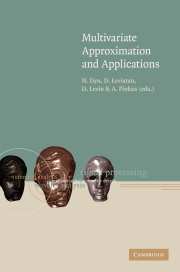Book contents
- Frontmatter
- Contents
- List of contributors
- Preface
- 1 Characterization and construction of radial basis functions
- 2 Approximation and interpolation with radial functions
- 3 Representing and analyzing scattered data on spheres
- 4 A survey on L2-approximation orders from shift-invariant spaces
- 5 Introduction to shift-invariant spaces. Linear independence
- 6 Theory and algorithms for nonuniform spline wavelets
- 7 Applied and computational aspects of nonlinear wavelet approximation
- 8 Subdivision, multiresolution and the construction of scalable algorithms in computer graphics
- 9 Mathematical methods in reverse engineering
- Index
5 - Introduction to shift-invariant spaces. Linear independence
Published online by Cambridge University Press: 06 July 2010
- Frontmatter
- Contents
- List of contributors
- Preface
- 1 Characterization and construction of radial basis functions
- 2 Approximation and interpolation with radial functions
- 3 Representing and analyzing scattered data on spheres
- 4 A survey on L2-approximation orders from shift-invariant spaces
- 5 Introduction to shift-invariant spaces. Linear independence
- 6 Theory and algorithms for nonuniform spline wavelets
- 7 Applied and computational aspects of nonlinear wavelet approximation
- 8 Subdivision, multiresolution and the construction of scalable algorithms in computer graphics
- 9 Mathematical methods in reverse engineering
- Index
Summary
Abstract
Shift-invariant spaces play an increasingly important role in various areas of mathematical analysis and its applications. They appear either implicitly or explicitly in studies of wavelets, splines, radial basis function approximation, regular sampling, Gabor systems, uniform subdivision schemes, and perhaps in some other areas. One must keep in mind, however, that the shift-invariant system explored in one of the above-mentioned areas might be very different from those investigated in another. For example, in splines the shift-invariant system is generated by elements of compact support, while in the area of sampling the shift-invariant system is generated by band-limited elements, i.e., elements whose Fourier transform is compactly supported. The theory of shift-invariant spaces attempts to provide a uniform platform for all these different investigations of shift-invariant spaces. The two main pillars of the theory are the study of the approximation properties of such spaces, and the study of generating sets for these spaces. The chapter by Kurt Jetter and Gerlind Plonka provides excellent up-to-date information about the first topic. The present chapter is devoted to the latter topic. My goal is to provide the reader with an easy and friendly introduction to the basic principles of that topic. The core of the presentation is devoted to the study of local principal shift-invariant spaces, while the more general cases are treated as extensions of that basic setup.
- Type
- Chapter
- Information
- Multivariate Approximation and Applications , pp. 112 - 151Publisher: Cambridge University PressPrint publication year: 2001
- 19
- Cited by



